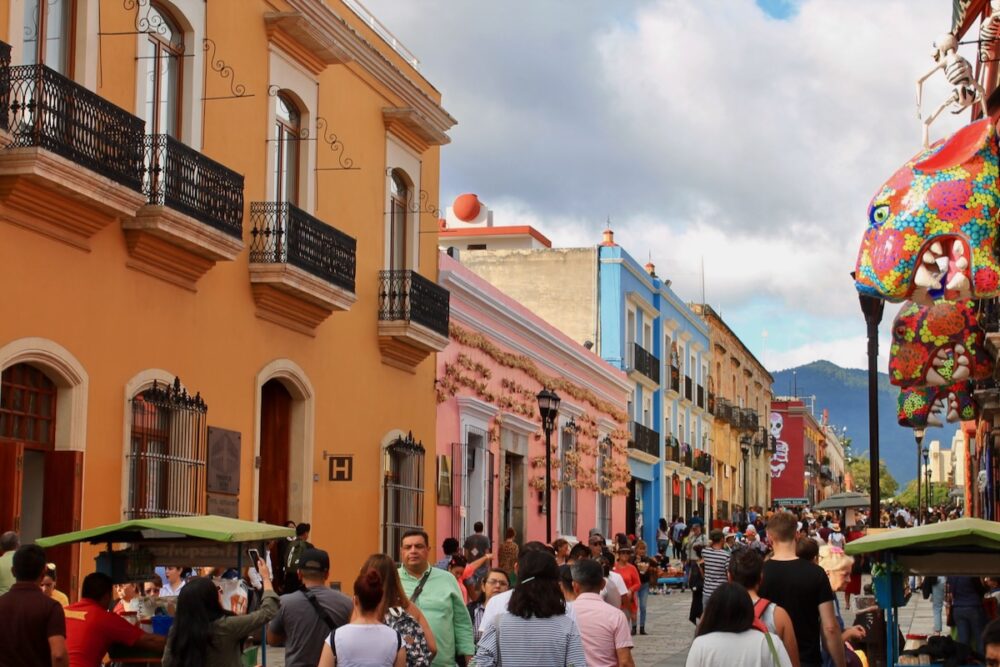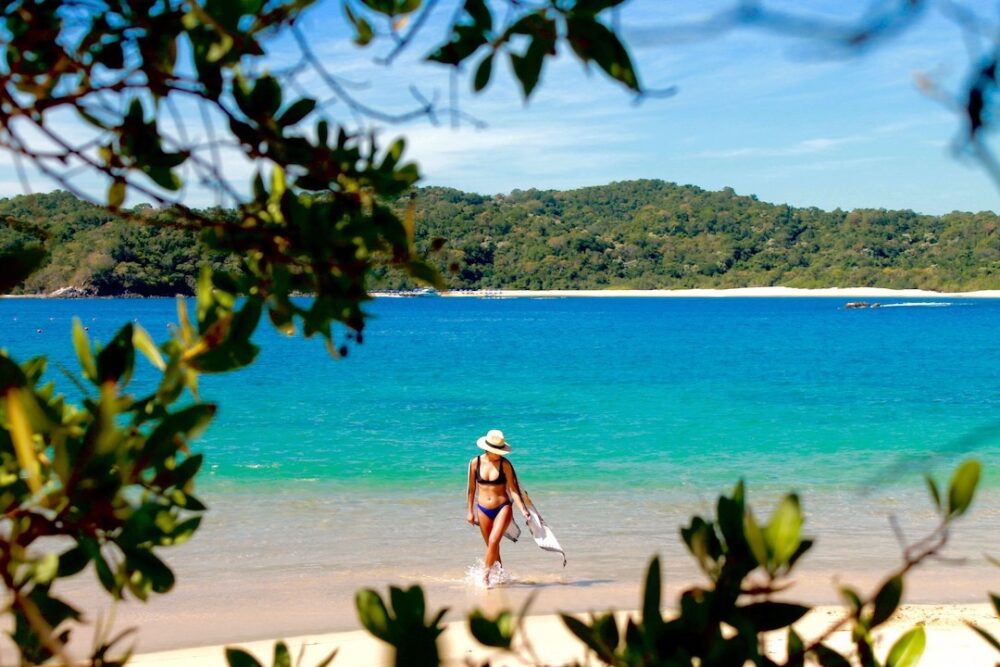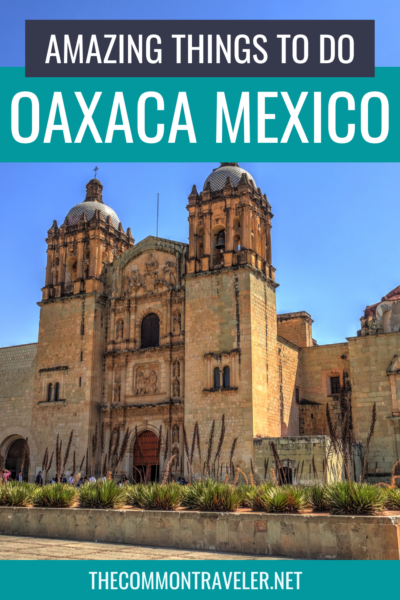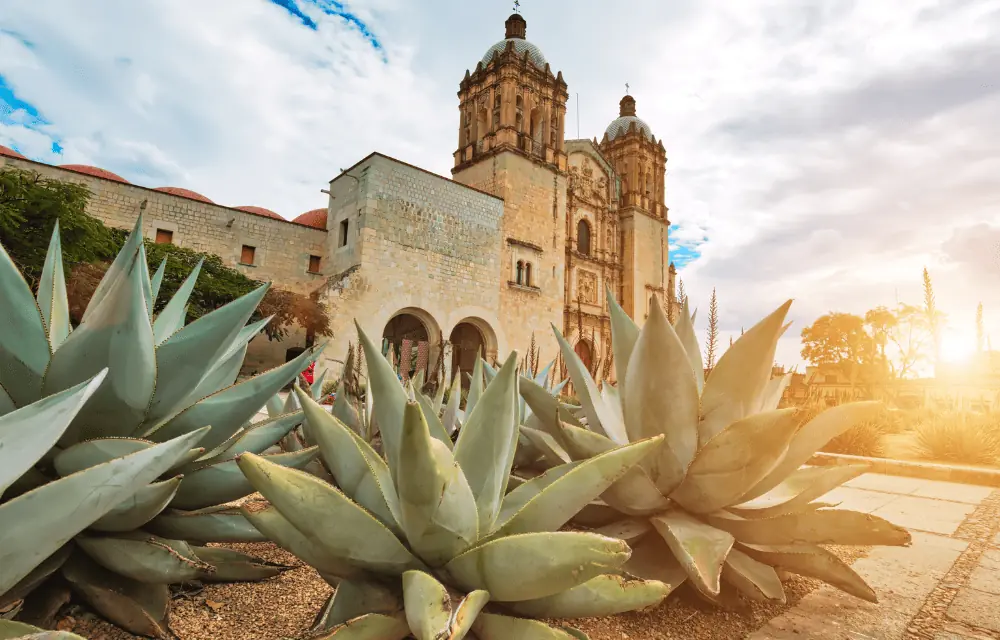We may earn money or products from the companies mentioned in this post.
Guest post by Eddie of The Vanabond Tales
Authentic, unique, and naturally abundant, Oaxaca is one of our favorite states in Mexico and a place that keeps pulling us back.
The mountainous state in southern Mexico is renowned for its rich cultural heritage, vibrant traditions, and varied landscapes. Oaxaca offers some of the most unique and authentic experiences in all of Mexico. For the adventurous traveler, prepared to get off the beaten path, Oaxaca state has much to offer, from its charming colonial towns, ancient archaeological sites, distinctive and delicious cuisine, awe-inspiring natural wonders, and rugged coastline.

Things to Do in Oaxaca Mexico: Explore Oaxaca City
The gateway to Oaxaca State and its capital, Oaxaca City remains one of the most fascinating and unique cities in all of Mexico. An eclectic mix of new and old, amongst the cobblestoned streets of the old colonial town some of Mexico’s most fascinating culture, history, and gastronomy can be found.
Discover Southern Mexico’s Cultural Epicenter
The cultural heart of Oaxaca State and indeed all of southern Mexico, Oaxaca City has become a beacon for artisans and craftspeople. There are many galleries and museums throughout the city featuring both traditional and contemporary art in many different mediums, including painting, sculpture, and film. Additionally, you’ll find local stores and markets where craftspeople ply their trade, maintaining and developing traditional techniques of production.
Cultural celebrations and events are frequently featured in the city’s performance spaces and public arenas. The most famous and significant cultural celebration is the annual Dias de los Muertos, the days of the dead, which take place in late October and early November. During Dias de los Muertos the town’s streets and cemeteries burst with color and noise in a beautifully vibrant and loud celebration of friends and family who have passed.

Uncover the History of Oaxaca City
Oaxaca City is also a historical wonder holding the keys to a colonial past and the indigenous Zapotec culture that long predated it.
The city’s small zócalo, the Plaza de la Constitucióna is considered the heartbeat of Oaxaca. The bustling public square is surrounded by restaurants, vendors & historic buildings and makes the perfect jumping-off point to begin your exploration of Oaxaca City’s history.
The Templo de Santo Domingo is another historical highlight not to be missed. Dating back to the 16th century the catholic church is not only an incredible example of baroque architecture but an important piece of Oaxaca’s history.
Just ten kilometers from the city, Monte Albán is one of Mexico’s most recognizable and important ancient ruins, preserving the rich history of the Zapotec. Perched high on a mountaintop, the site was one of the earliest cities of Mesoamerica as well as the social and economic center of the Zapotec empire for almost one thousand years.
Immerse in the Markets and Daily Life
Oaxaca is a hive of activity, thanks in part to the frenzy of tourism that has arisen here to cater to the more than one million visitors that descend on the city each year, and also from locals going about their daily lives in the busy state capital.
There are a number of places to take in the energy of the city such as the Zocolo and the Andador de Macedonia Alcalá but perhaps none are so authentic as the Mercado Benito Juárez. Just one block south of the central plaza this massive covered market takes up an entire block and specializes in produce, prepared foods, crafts & textiles.

Indulge in Oaxacan Gastromomy and Cuisine
Oaxacan cuisine is legendary throughout Mexico as some of the most delicious and unique the country has to offer.
Oaxacas distinct traditional cuisine and street food can be found in restaurants and on street corners throughout the state, however, the city of Oaxaca is home to a concentration of some of the best restaurants in the country. Including a new wave of modern and innovative restaurants that have sprung up here, helping to make Oaxaca City one of the most important gastronomic hubs in a country renowned for its food.
Mole, the tlayuda and tamales oaxaqueños are just some of the delectable Oaxacan specialties that this region is known for. On the street and in the bustling mercados, or in small unassuming restaurants you’ll find some of the best traditional meals Oaxaca has to offer.
Beyond the unique local dishes, the city has both produced some of Mexico’s best chefs such as Alejandro Ruiz Olmedo and attracted culinary masters like Enrique Olvera from other parts of the country.
Take some time to seek out the unique and sublime restaurants and bars that have helped cement Oaxaca City as one of the most important gastronomic destinations in the country.
Beyond sampling the unique dishes and fabulous restaurants of Oaxaca City, visitors can sample the raw produce for which the region is known including locally produced mezcal, Oaxacan cheese, and chocolate.
Things to Do in Oaxaca Mexico: Experience the Indigenous Culture, Ancient Ruins, Colonial Towns, and Natural Wonders of Greater Oaxaca
The various towns, landmarks, communities, and regions throughout Oaxaca all have a story to tell. From the local mezcal production, ancient ruins, incredible natural wonders, and traditional communities the towns of Oaxaca form a vibrant tapestry of culture, history, and personality.
Observe Weaving Traditions and Textile Artistry in Teotitlán del Valle
A vibrant Zapotec village named for the valley in which it is found, Teotitlán del Valle is fiercely proud of its rich cultural heritage, particularly its time-honoured tradition of weaving exquisite textiles using natural dyes and ancient techniques.
The village of Teotitlán del Valle has a long history dating back to pre-Hispanic times. Its name translates to “place of the gods,” reflecting the deep-rooted indigenous spirituality that is still present in the community today. The Zapotec culture is celebrated and preserved through various aspects of daily life.
Visitors have the opportunity to witness the weaving process and purchase unique handcrafted rugs, blankets, and other textile products directly from the artisans.
If you haven’t had your fill of unique artisan crafts consider continuing your journey to the village of San Bartolo Coyotepec. This picturesque town is also renowned for its artistic heritage, namely the distinctive black pottery, known as “barro negro.”

Marvel at the Ancient Ruins and Intricate Stone Mosaics of Mitla
Twenty minutes from Teotitlán the important archeological site of Mitla can be found.
The ancient ruins feature a complex that functioned as a ceremonial and religious site for the indigenous Zapotec people. Amongst the structures, temples, palaces, and tombs have been identified here.
Mitla is well known for its well-preserved mosaic fretwork that adorns much of the structure, highlighting the incredible craftsmanship of the Zapotec.
Photograph the Surreal Petrified Waterfall and Natural Infinity Pools at Hierve el Agua
One of the most photographed sites in Oaxaca, the Hierve el Aguas is a surreal and picturesque landscape created by petrified waterfalls and mineral-rich rock formations. 70 kilometers southeast of Oaxaca City the waterfalls are nestled in the mountainous region of the Central Valleys.
Fed by springs, the mineral-heavy waters of the Hierve el Aguas flow down the cliffside leaving mineral deposits that, over thousands of years, have created the appearance of cascading waterfalls frozen in time.
Above the falls, are natural infinity pools with a turquoise hue that create stunning and surreal pictures.
Hiking trails in the area give explorers the chance to see more of this naturally abundant pocket of Oaxaca.
Take in the Majestic Tree of Tule in Santa María del Tule
El Árbol del Tule or, the Tree of Tule, is a massive and ancient Montezuma cypress tree over 2000 years old. Located in the town of Santa María del Tule, it is one of the largest and widest trees in the world standing approximately 40 meters tall with an extraordinary circumference of about 58 meters. It has become a symbol of the region’s natural heritage and cultural identity.
Uncork Mezcal in Santiago Matatlán
A small village located renowned for its production of traditional mezcal Santiago Matatlán is situated in the picturesque Oaxacan countryside. Matalán has been referred to as “The Capital of Mezcal” due to its significant role in the history of production and distribution of the famed agave spirit.
The village is home to numerous mezcal distilleries, known as palenques, where the production process is still carried out using traditional methods.
Visitors to Santiago Matatlán have the opportunity to witness the mezcal-making process firsthand, from the harvesting of mature agave plants to the fermentation and distillation stages and of course the final stages, sampling and purchasing some to take home.

Reach New Highs on the Balcony of the Pacific
Halfway between Oaxaca City and the Pacific Coast, high in the Sierre Sur Mountain Range, is the tiny town of San Jose del Pacifico.
A spiritual place, San Jose is known for its shaman-led temezcal or sweat lodge ceremonies and its long association with “hongos magicos” the hallucinogenic Psilocybin mushroom that grows wild here.
The cloud forest surrounding the town offers a temperate climate that has created a haven for a diverse range of flora and fauna as a result hiking and birdwatching are popular activities in the region.
Participate in Sustainable Eco-Tourism in the Pueblos Mancomunados
The Pueblos Mancomunados, or the “Communal Towns,” are a group of eight indigenous Zapotec communities located in the Sierra Norte mountains. These communities have come together to form a unique and sustainable ecotourism initiative, offering visitors an immersive cultural and natural experience while promoting community development and environmental conservation.
The Pueblos Mancomunados include the towns of Benito Juárez, Cuajimoloyas, La Nevería, Lachatao, Latuvi, Llano Grande, San Miguel Amatlán, and Yavesía. These communities have a rich indigenous heritage and, impressively, have managed to maintain their traditional way of life, deeply connected to the surrounding mountains and forests.
One of the primary goals of the Pueblos Mancomunados is to promote community-based ecotourism, which empowers local residents and ensures that the benefits of tourism are shared among the communities.
Visitors are encouraged to participate in sustainable eco-tourism by taking part in a variety of traditional, guide-led activities and by traveling between the different towns by hiking, horseback riding, or mountain biking between them.
Things to Do in Oaxaca Mexico: Oaxaca’s Stunning Coastline

Hunt for Crocodiles Amongst the Mangroves of Lagunas de Chacahua
A hidden beach, only accessible by navigating a labyrinth-like maze of mangroves that stretch across a croc-invested estuary, the legendary Chacuhua rewards intrepid explorers with the peaceful and unspoiled beach of Playa Chacuhua.
While getting there s half the fun, visitors will appreciate the limited infrastructure and the opportunity to connect with nature that few other places can offer. Surf and sunbathe during the day, sit by the bonfire at night, and drift to sleep to the sounds of the pacific ocean.
Get Heavy in Puerto Escondido
The official surf town of Oaxaca and gateway to the Oaxacan coast, Puerto Escondido has developed a reputation as a hedonistic beach destination for surfers seeking heavy waves and backpackers looking for buzzing nightlife.
Beyond the thrashing waves of Zicatela, affectionately referred to as the Mexican Pipeline, Escondido is also home to beautiful protected coves and gentler beaches for beginners to learn to surf such as La Punta.
When night falls Puerto Escondido is renowned for its rowdy nightlife, with many restaurants, beach bars, and all-night clubs.
Chill Out in Muzunte, Zipolite and San Augustinillo
Zipolite, Mazunte, and San Agustinillo are three charming beach towns located together on the southern coast of Oaxaca. Each town has its own distinct character, offering visitors a unique experience of sun, sand, and a laid-back atmosphere.
Zipolite is known for its beautiful long stretch of beach and its bohemian vibe. It has gained a reputation as a haven for free-spirited travelers and as a nudist-friendly destination. Zipolite’s relaxed atmosphere and stunning sunsets make it a favorite spot for those seeking a tranquil and alternative beach experience.
Mazunte, located just south of Zipolite, is famous for its eco-friendly and sustainable practices. It is home to the National Mexican Turtle Center, where visitors can learn about the conservation efforts of different species of sea turtles. The town also promotes a variety of holistic and alternative lifestyles, with yoga retreats and wellness centers offering various healing practices.
Finally, nestled between the two, the small village of San Agustinillo, offers a quieter and more laid-back ambiance. Its palm-fringed beach provides a tranquil setting for swimming and sunbathing. The town has a selection of cozy accommodations and beachfront restaurants where visitors can savor delicious seafood dishes and enjoy stunning ocean views.

Admire the Natural Beauty of Hualtuco
Striking a balance between natural beauty, modern amenities, and authentic Mexican charm, Huatulco, on Oaxaca’s southern coast is renowned for its stunning beaches, and lush natural landscapes.
Playa Santa Cruz, the main beach in Huatulco, is a hub of activity with restaurants, shops, and a marina where visitors can embark on boat tours or fishing trips. Meanwhile, those seeking a more serene experience will find it in the Huatulco National Park, which offers a naturally spectacular and abundant section of the coastline marked by incredibly picturesque bays and rugged coastal scrub.
Final Thoughts on Things to Do in Oaxaca Mexico
With its rich cultural heritage, breathtaking landscapes, and warm people, Oaxaca is a place that stays with you long after your trip has ended.
Even a short time in Oaxaca reveals why this region is so important. Safeguarding ancient historical treasures, protecting unique cultural identity, preserving tradition, and conserving the beautiful natural environment, Oaxaca clearly plays a special role in southern Mexico.
For travelers, the state’s colonial towns, archaeological sites, and natural wonders provide an exciting glimpse into its diverse cultural tapestry formed over millennia of history and the endless beauty of the region. Once you visit it’s a place that will call you back again and again.
About the Author
Eddie is the author and creator of The Vanabond Tales, a travel blog focused on slow travel, minimalist travel adventures that are budget-friendly, outdoor-focused, and environmentally conscious. You’ll currently find him and his wife Kelli aboard their boat Whisper sailing the Mediterranean.
Check out these other Mexico posts:








 Raised as a third culture kid living in South America and Europe, Annick caught the travel bug early. As an empty-nester, Annick enjoys sharing her tips for traveling for those with champagne taste and beer budgets.
Raised as a third culture kid living in South America and Europe, Annick caught the travel bug early. As an empty-nester, Annick enjoys sharing her tips for traveling for those with champagne taste and beer budgets.